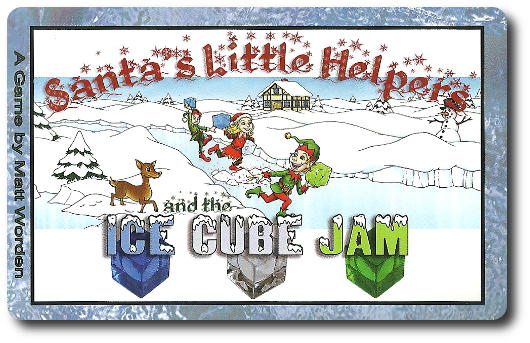
The Basics:
- For ages 6 and up (publisher suggests 12+)
- For 2 to 6 players
- Approximately 30 minutes to complete
Geek Skills:
- Counting & Math
- Logical & Critical Decision Making
- Pattern/Color Matching
- Strategy & Tactics
- Hand/Resource Management
Learning Curve:
- Child – Easy
- Adult – Easy
Theme & Narrative:
- Help Santa before the other elves do
Endorsements:
- Gamer Geek mixed!
- Parent Geek approved!
- Child Geek approved!
Overview
If the stories are true, Santa has a lot of elves at his beck and call. With so many happy workers, you just know there are problems underneath the festive surface. The elves have their own rivalries and compete to be Santa’s “Top Elf”. Even the smallest task becomes an aggressive competition. In this game, the Holiday Spirit hits hard and plays for keeps.
Santa’s Little Helpers and the Ice Cube Jam, designed by Matt Worden and published by Matt Worden Games via the Game Crafter, is comprised of 40 Map cards, 36 Cubes (of 3 different colors), 6 Player pawns, 6 Tracking cards, 1 “Santa’s Workshop” Map card, and 1 bag. The cards are as thick and as durable as your standard playing card. The pawns and cubes are made of solid plastic. The illustrations and layout of the cards is festive, further strengthening the game’s theme. A free print-and-color page (PDF) is offered directly from the game designer that provides young artists an opportunity to add their own creative talent to the game’s lead illustrator, Kristijan Hranisavljevic, title illustration. If the artist (and their parents) like, they can send a copy of the completed coloring work back to the game designer who will feature it on the game’s main web page.
Bundling Up for the Cold
To set up the game, first have each player select 1 Player pawn of their choice and 1 Tracking card. Have the players place the Tracking card in front of them, face-up. Place any Player pawns and Tracking cards not used back in the game box.
Second, place all the Cubes into the bag and mix them around. Place the bag to one side.
Third, find and place the “Santa’s Workshop” Map card in the middle of the playing area, face-up. Shuffle the remaining Map cards and place the first 14 face-up around the “Santa’s Workshop” Map card. Make sure the cards are aligned the same way as “Santa’s Workshop”. The end result will be a 5 x 3 grid of cards with “Santa’s Workshop” in the middle.
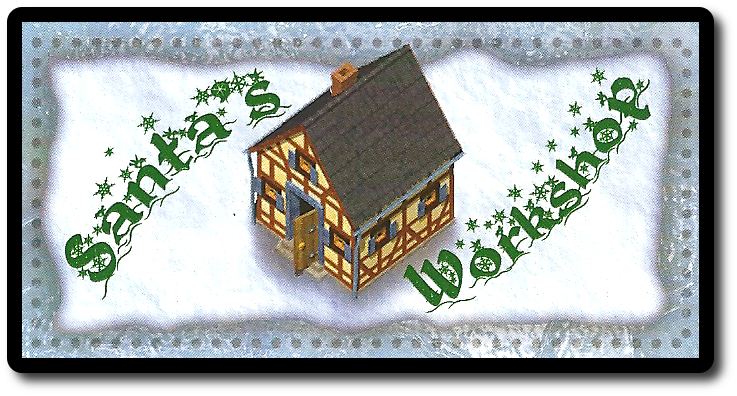
To quote another game reviewer, “Shut the door!”
Fourth, randomly draw 1 Cube per “snowflake” symbol shown on each card in the grid, placing the selected Cube on the square area of the Map card.
Fifth, place the remaining Map cards face-down to one side of the grid. This is the Map card draw deck for the duration of the game. Draw the first 3 Map cards and place them in a row next to the Map card draw deck. This row is referred to as the “Left-Overs Street”. Do not add Cubes to these cards.
That’s it for game set up. All players place their Player pawn on the “Santa’s Workshop” Map card. Determine who will go first and begin.
A Winter Wonderland
Santa’s Little Helpers and the Ice Cube Jam is played in turns with no set number of turns per game. A player’s turn consists of 2 sequential steps, but the steps are both optional. Meaning the player could skip the first step and go right to the second or only do the first step. They could technically not do anything at all on their turn, but where’s the fun in that? A player’s turn is summarized here.
Step 1: Add to the Winter Wonderland
The first action the player can optionally take on their turn is select 1 Map card face-up from the Left-Overs Street and add it to the grid. Added Map cards must be aligned to the existing Map cards on the grid. This can be done by placing the Map card so at least 1 of its 2 squares is adjacent to another Map card or 1 of the new Map card’s squares overlays 1 square of a previously placed Map card. In this way, player can adjust and rotate how the grid is built. The only restrictions when it comes to overlaying a previously placed Map card is that a Cube, a Player pawn, and the “Santa’s Workshop” Map card can never have another Map card placed on top of them.
After the new Map card is placed, draw 1 Cube for each snowflake symbol and place it on the Map card. A new Map card is then drawn and added to the Left-Overs Street to replace the taken card.
If the player wants to add a new Map card to the grid, but the draw deck for the Map cards is empty, they can either select 1 of the Map cards in the Left-Overs Street or pick up any Map card already attached to the grid. The taken card from the grid must be on the outside portion and not have any Cubes or Player pawns located on it. Additionally, the taken Map card must not “orphan” another Map card, meaning the removal of the Map card does not break the grid into two portions.
Step 2: Take a Step
The second action the player can optionally take on their turn is moving their Player pawn. Each player is given 2 steps, where a step is moving the Player pawn from 1 square to an adjacent square. Each Map card is comprised of 2 such squares. Movement is always orthogonal and never diagonal. Additionally, the following rules apply.
- A Player pawn can never occupy or pass through another Player pawn
- A Player pawn can never move off the grid
- Stone walls stop a Player pawn (treat them like an opponents’ Player pawn)
- Any number of Player pawns can move through and stop on the “Santa’s Workshop” Map card
There are 3 different types of terrain. These are snow (A), ice (B) and stone walls (D). Any square containing a square wall is impassable. A Player pawn may go around it, but never stop on it or go through it (as explained above). The snow will stop a player, but only temporary. A new cube is placed on each of the snowflake symbols (C) when the Map card comes into play.
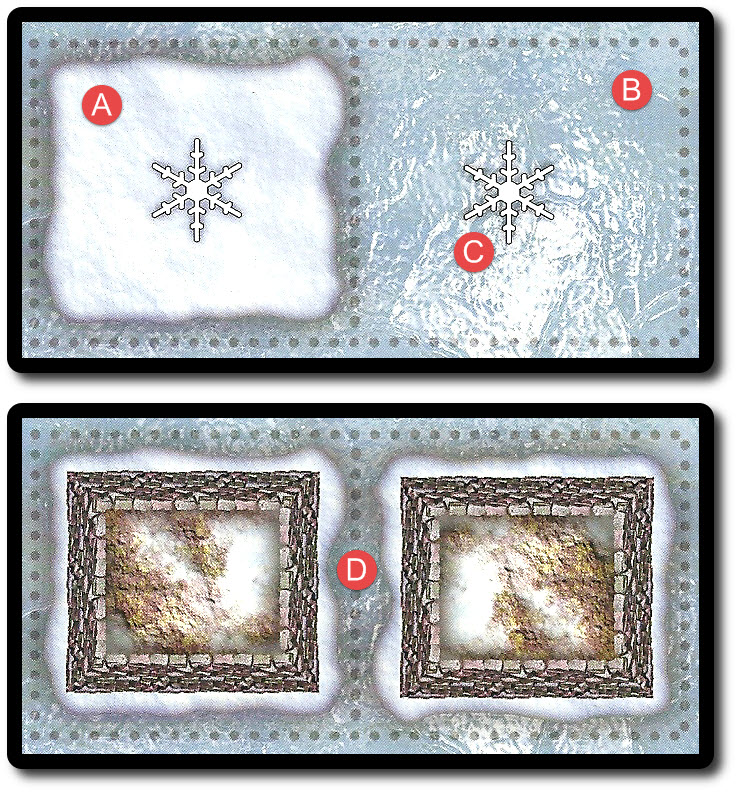
It takes 1 step to move 1 square full of snow. Ice also takes 1 step to traverse, but a Player pawn can “slide” on ice. A player must announce they are sliding when they move their Player pawn to the ice terrain. If they do, they can continue to move their Player pawn in a straight line in a direction that matches their initial step until their Player pawn encounters another Player pawn, the edge of the grid, snow, or a stone wall. Sliding does not take an additional step. A player cannot stop their slide prematurely or turn, making this type a move a quick way to traverse the grid, but it’s not a method that gives the player a great deal of control.
After finishing their turn, the player announces they are done and the next player in turn order sequence goes.
Festive Fruits
Thematically speaking, each player is attempting to collect a set of magical fruits that magically appear in the Winter Wonderland around Santa’s Workshop. In game terms, the players are attempting to grab a set of 3 Cubes as fast as they can by moving about the grid. This is not as easy as it sounds, as there are limitations to what can be held and the movement restrictions already discussed. A player need not stop on a space with a Cube to pick it up. For example, a player can slide through a space with a Cube and decide to pick it up or leave it.
A set of Cubes is comprised of 1 green, 1 blue, and 1 white Cube. A player can only hold 1 of each color when they are being collected, meaning a player will most likely have to move about the grid a number of times to collect what they need. Once a Cube is plucked, it belongs to the player, but a new Cube does not get added unless a new Map card with a snowflake symbol is placed. Eventually, players will run out of Cubes and will need to add Map cards, which is not a bad thing, but Map cards are added to the outskirts of the existing grid, making the distance to and from Santa’s Workshop longer.
The Tracking cards help players organize the Cubes they are holding and those they have scored. When a Cube is picked up, it’s placed at the top of the Tracking cards, signifying that the player is carrying it.
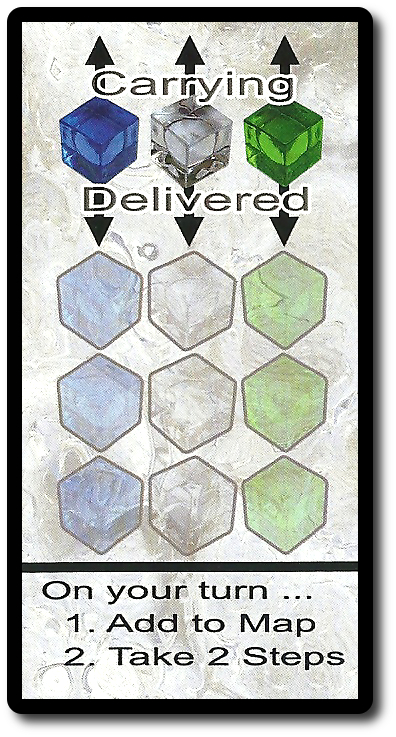
Scoring a complete set of Cubes requires the player to venture back to “Santa’s Workshop” where they are thematically deposited. Game wise, scored Cubes are moved onto the card and are considered delivered. The player can now carry more Cubes.
Jingle Bell Jam
The game continues until 1 player has collected the necessary number of sets to win the game. The number of sets required is based on the number of players. Either 2 or 3 sets will be needed to win over Santa Clause. For the winner, they will get the best present of all: Santa’s praise. Everyone else will be asked to go clean out the reindeer stables.
To learn more about Santa’s Little Helpers and the Ice Cube Jam, visit the game’s web page.
Final Word
The Child Geeks quickly learned how to play and easily navigated the different obstacles to claim the magical fruits. I was most impressed with their ability to adapt quickly to the changing landscape and stolen Cubes. Not that they felt good about it, mind you, but they pushed through and persevered. According to one Child Geek, “You have to be quick or the Cubes will go fast. The best thing to do is attempt to go for those that no one wants yet.” A viable strategy! Another Child Geek said, “You need to be fast and take the best route. If you spend too much time on the ice, you’ll be left out in the cold.” At which point the Child Geek laughed and laughed at their pun. Which was actually pretty funny and spot on. After collecting the Cubes and sliding on the ice, the Child Geeks all voted to approve Santa’s Little Helpers and the Ice Cube Jam, finding it to be a perfect game for the Holidays or whenever fun was called for.
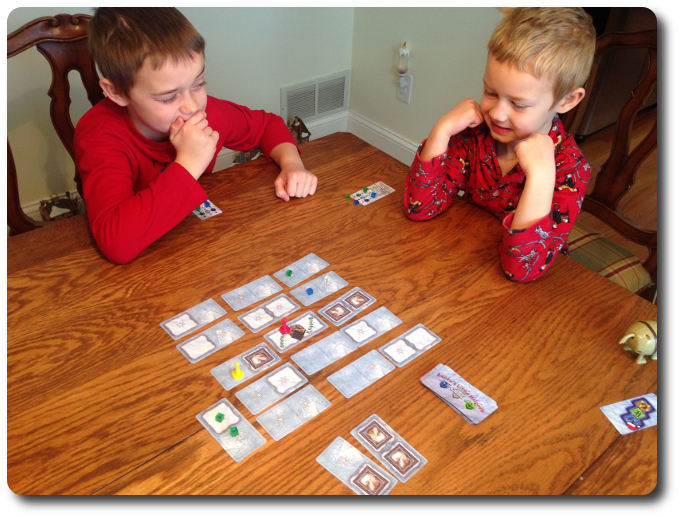
The Child Geeks saw the game as a race and they went out of their way to skunk the competition
The Parent Geeks also had a lot of fun, finding the game to be perfect for the family and a good time with just their peers. According to one Parent Geek, “The theme is silly, but perfect for the Holidays. It’s also an entertaining game. Good stuff.” Another Parent Geek said, “Easy to learn and fun to play, this might be the next game I buy and look forward to playing each year around Christmas.” Despite the game’s theme, many of the Parent Geeks believed that the game would be a welcomed addition to their gaming table all year round. When all the jam was jarred, the Parent Geeks approved the game.
The Gamer Geeks took note of the game’s tight design and the surprising level of strategic depth that it called for. According to one Gamer Geek, “I was pretty sure this game was going to suck, but it’s actually pretty good.” High praise, indeed. Another Gamer Geek said, “This is pretty light game, but it was obviously designed by someone who knows what makes a good game good.” None of the Gamer Geeks believed that Santa’s Little Helpers and the Ice Cube Jam was a bad game. In fact, they all agreed it was one of the better – if not best – Holiday themed games they had played in a long while. What they could not agree upon was if the game was right for them. Roughly half of the Gamer Geeks we played with found the game to be light, engaging, and entertaining enough to be a viable filler. The other half, while giving the game full points for being well designed, decided that Santa’s Little Helpers and the Ice Cube Jam was a game lacking the right amount of depth, strategy, and tactics to make it a welcomed addition to the elitists’ gaming table.
Unfortunately, this is a game that many will dismiss out of hand due to its title or theme. A shame for those who do because they are missing out. Santa’s Little Helpers and the Ice Cube Jam has a surprising level of depth and requires tactical as well as strategic thought. Not to a point where this game should be considered difficult, however. Its charm is not the elves or Christmas theme. Rather, this game makes one smile because beneath its festive surface lies a genuine challenge that will cause players to lean forward and become engaged in a no holds barred race on ice.
One of the biggest surprises was the game’s level of complexity at times. Since the grid is always built randomly, a random number of Cubes are placed. Furthermore, the Cubes are drawn at random, as well. This makes the position of the Cube and its type different each and every time. A player might have to go from one end of the grid to another just to complete a set or race like crazy to pick up the closest Cubes. But a player will quickly learn that low hanging magical fruit in this game is not necessarily something to be reached for. This game is really about logistics and determining, again and again, the most effective route that should be taken to claim the most Cubes as quickly as possible. It’s not as easy as it sounds, but the game does not present the problem to be solved as an impossible riddle. Any player can collect a Cube, but it takes a great player to know in which order the Cubes should be collected.
Cunningly, the game designer allows players to replace squares on the grid to create larger slides, bigger stone walls, and other snowy obstacles. This is important to the players for two reason. First, Map cards must always extend the current grid, creating a larger area for the players to traverse. Second, new Cubes are only entered into the game once a new Map card is placed. More than just a few players will most likely want the new Cube, so a player must consider carefully how and where to place their Map card. If they don’t need the Cube, then perhaps they should place the Map card as far away as possible from them so as to create distance between themselves and the competition. Of course, if they need the Cube, then they best place the Map card where they can easy get to it. Which all sounds great until we consider you do not draw a Cube until after the Map card is placed. This means players have to consider not one, but both possibilities.
I was told by the game designer that one of his intents was to design a game that could be used as a stocking stuffer. But for whom? Based on our observations and collected comments, Santa’s Little Helpers and the Ice Cube Jam would be a welcomed gift by everyone save those most elite and hardcore game players. Which, honestly, should come as no surprise to anyone. But for everyone else, here is a game that offers entertainment with just the right amount of game play to keep everyone involved, challenged, and competitive. Do consider putting this game in a loved one’s stocking or under your Christmas Tree so you can enjoy it at the gaming table.
This game was given to Father Geek as a review copy. Father Geek was not paid, bribed, wined, dined, or threatened in vain hopes of influencing this review. Such is the statuesque and legendary integrity of Father Geek.



